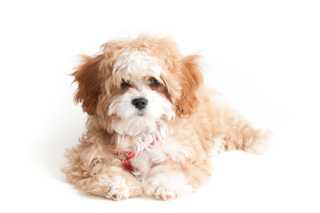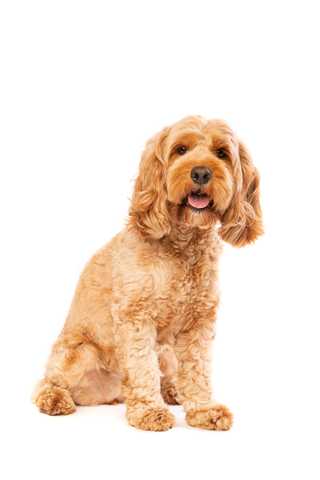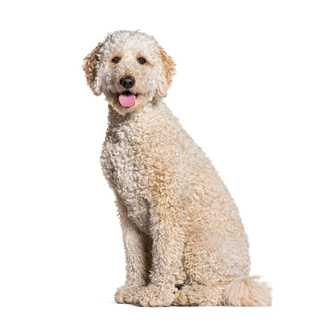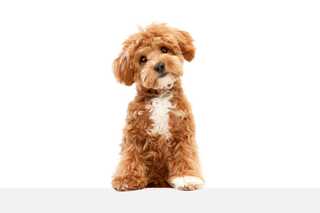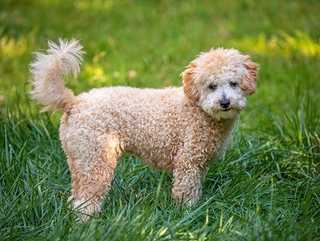
Note: While the breeds in this collection tend to be Designer Dog Breeds, individual pets will vary. Please consult the adoption organization for details on a specific pet.
It’s a catchy phrase, but what exactly does it mean? “Designer Breed” brings cute and often fluffy canines to a dog-lover’s mind. However, it also causes dismay in some animal welfare advocates and dog enthusiasts. What exactly is a designer breed, and why does the term create such a range of emotions?
A “Designer Breed” is a popular name for the intentional crossbreeding of two purebred dogs of different breeds with the intent to combine particular desirable traits from one or both parents. These crossbreeds are usually bestowed with a descriptive name that combine part of each parent breed (Maltipoo, Aussiedoodle, Labradoodle, and the like). Some serious enthusiasts have created professional associations to develop and maintain conformation standards for a few of the most popular designer dogs. However, designer dogs are not official breeds recognized by the AKC.
When Did Designer Breeding Start?
For most of the 20th century, we had purebred dogs and mixed breed dogs. Purebred dogs descended from generations of the same breed, and generally conformed to a specific breed standard. A mixed breed dog, or mutt, was any dog who had parents of different breeds. Simple, right?
A hint of a change came in the 1960s with the Cockapoo, a Poodle and Cocker Spaniel mix. Both breeds were popular purebred family pets. Breeders noted their unique attributes -- for example, the people-oriented affection of the Cocker and the low-shedding coat of the Poodle – and began crossing the two to help create an ideal family pet.
It wasn’t until decades later that the Cockapoo lost its solo status as an intentional crossbreed. In 1989, Wally Conron of the Royal Guide Dogs Association of Australia crossbred a Labrador Retriever and a Poodle to provide a non-shedding guide dog of steady temperament for a blind woman whose husband was allergic to dogs. His focused breeding of the Labradoodle lit a spark in the world of dog enthusiasts, and other dog breeders began crossbreed matches based on desirable breed attributes. The low-shedding Poodle was a favorite half, bringing us Goldendoodles, Aussiedoodles, Maltipoos and others. Sometimes breeding choices were made to help reduce the problems a purebred was known for. The Puggle, a Beagle/Pug crossbreed, had a longer (but still sweetly puglike) muzzle that reduced the brachycephalic, snorting breathing problems that many purebred pugs experienced.
Crossbreeding flourished in the 80s and 90s and the term “Designer Breed” entered the canine lexicon. While not “breeds” at all, the term captured the popular imagination with a trendy flair.
Why Do Some People Dislike the Term “Designer Dog?”
It’s not surprising that some individuals identified the profit potential in the designer dog trend and began breeding different crosses without a focused goal. No pedigree is required for a non-purebred dog, so puppies could sell on cuteness alone. Even Wally Conron, who carefully bred those first Labradoodles with a trusting human-animal partnership in mind, stated that he regretted beginning a trend that paved the way for “unethical, ruthless people” to crossbreed dogs indiscriminately, increasing the risk of congenital disease.
So, while some people applaud the designer breed movement for providing new options for family-friendly pets, others worry that the negatives outweigh the benefits.
Are Designer Dogs Available for Adoption?
Absolutely, and a shelter should be a first place to look! When any breed of dog suddenly becomes popular, shelters and rescues are the safety net for those who end up homeless, and they often experience a surge of those breeds as strays and owner-surrenders. No matter what type of dog you are looking for, check in with your local shelter, or search online on Petfinder, where many of the most well-known designer dog titles are listed in the search engine to help match these mixes with new and loving homes.
What Are Some of the Most Popular Designer Dogs?
Here is a bit of an introduction to 5 popular crossbreeds that can be good matches for families who are prepared to meet their grooming and playtime needs.
1. The Goldendoodle
is a friendly, loving family companion. This mix of Golden Retriever and Poodle is a great fit for a family who loves to play. The Goldendoodle did not appear in America until the 1990s but gained popularity due to their happy personality and lower-dander coat. With two active breeds in the bloodline, the Goldendoodle has a high energy level combined with people-pleasing smarts. Expect to devote some time each day exercising and training your activity-loving Doodle.
2. The Cavapoo
is a Cavalier King Charles Spaniel and Poodle crossbreed developed in the late 1990’s in Australia. This pup is a true people dog. They thrive on human contact, so pet parents should begin thoughtful socialization during puppyhood to avoid problems with separation anxiety. They have smart minds that enjoy the challenge of training, so sign up for an obedience class or learn a few tricks together!
3. The Cockapoo
the first Cockapoos (Cocker Spaniel/Poodle) were likely accidental, but as they gained a positive reputation as a family dog, breeders began intentionally combining the two breeds. The Cockapoo is an extremely friendly and happy dog. You’ll find that this dog is up for any lesson or game and tends to accept other pets in the home, too.
4. The Maltipoo
is a Maltese and Poodle crossbreed, an all-around family dog: happy at play, in a lap, and often enjoys children and other pets. The Maltipoo’s date of origin is unknown. They were bred in the United States to be a small, affectionate companion. While no dog is completely hypoallergenic, the Maltipoo may inherit a tendency to have less dander from the Poodle parent, making them a possibility for a family trying to manage allergies.
5. The Morkie
is a Maltese/Yorkshire Terrier cross, and at around 13 pounds is an option for someone partial to smaller canines. The Morkie bounced into family homes in the late 1990s, although accidental breeding likely appeared before then. Morkies have lots of energy, a smart brain, a bit of stubbornness, and a reliable bark, all wrapped up in one small-and-cute canine package.
When considering a designer crossbreed, it’s important to also research the temperament, upkeep, and health issues of their parent breeds, as there is no surety which breed will shine forth in the coat, energy level, and personality of their pups.
What you can be sure of is that any dog, regardless of breed, may be the perfect pup to find that place in your heart and home, so be open to considering them all!
